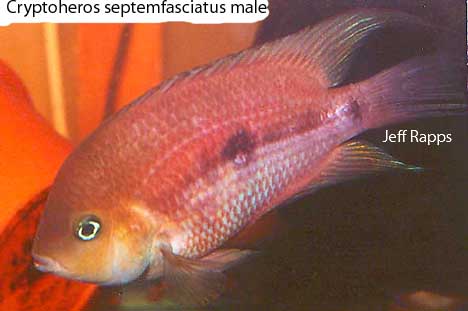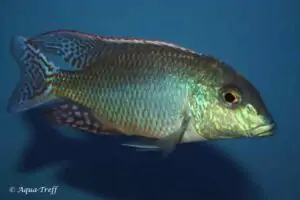Amatitlania septemfasciata
Amatitlania septemfasciata was first described by Regan in 1908. Amatitlania is derived from the type rather than the type species. “Amatitlán” means, a place of abundance in amate” in Nahuatl. “amate” is a type of paper made from the bark of Ficus petiolaris or Ficus indica. Sept = Seven, fascia = band. The Amatitlania with seven bands. A non-specific characteristic because all Amatitlania have seven bands. This does not mean that these are visible in all species under all circumstances, even with Amatitlania septemfasciatus this is not always the case.
Description
This cichlid, which remains small, can often be recognized by having two dark spots on the flank. One in the middle of the body (actually the middle of the third band) and the second on the caudal peduncle (the seventh band). Amatitlania septemfasciata is sexually dimorphic, that is, the sexes look different.
The males are larger (10 centimetres standard length) and have (depending on the location) a reddish or yellow belly side. These colors are also often found in the base of the dorsal fin. The ventral side of the man is also decorated with sky-blue scales. In females, this blue is even the basic color of the ventral part (head and belly). Above this, the female often shows a golden yellow zone that can extend from the gill covers to the beginning of the caudal peduncle. The females have a dorsal fin spot with this golden yellow colour repeating in between.
The females do not grow larger than 7 centimeters. During the mating season, the female’s color pattern changes dramatically. Then it is mainly the black and white tones that predominate.
One comment is in order here. And that is that there is probably as much variation in this fish as there are locations where they are found. So if your fish doesn’t quite fit the above description, it doesn’t necessarily indicate hybridization. Variety spreads in nature like the colors of a rainbow.

Furthermore, Amatitlania septemfasciata is closely related to its relatives Amatitlania sajica and Amatitlania myrnae. They differ from these species mainly by their conical rather than chisel-shaped teeth in the upper jaw and the two-pointed compound teeth in the lower jaw (Schmitter – Soto 2007). This different shape of the teeth may indicate a different way of foraging or a different diet. It is remarkable that this dental composition again shows similarities with that of Amatitlania altoflava. There is a lot of I.D. discussion on the internet about this fish, especially Amatitlania myrnae. More clarity about this can be found in the fish description of Amatitlania myrnae.
Behavior
The temperament of this fish does not keep up with the size. The fish are much spicier than you would expect. Especially during the mating season, the character of these dwarfs can be called enormous and they often manage to raise young even in overcrowded tanks.
Origin
Costa Rica, Nigaragua.
Distribution
Only on the Atlantic side, up to 600 meters altitude. From the border river San Juan, which officially belongs to Nicaragua, to the Rio Banano south of Limón. Here it inhabits the shallower parts of shady rainforest rivers. Amatitlania septemfasciata can be found in water with different flow rates, from the rapids in the upper reaches to the slow-moving waters in the lower reaches. But where Amatitlania septemfasciata occurs together with Amatitlania nigrofasciatus, Amatitlania septemfasciata more often seeks out the faster-flowing parts (Bussing 1989).
Diet
Amatitlania septemfaciata is a true omnivore. Insects and their larvae, small fish, snails, but also detritus, algae and fruits that have fallen into the water are on the menu. You can regularly observe how they forage with their belly and pectoral fins stirring up the bottom, swimming a little bit back and then see if anything edible has been uncovered. That’s how they feed their young. They have also been observed to turn over bottom-lying leaves while foraging (Artigaz 2011).
The Aquarium
The water in which Amatitlania septemfasciata naturally occurs is in all cases oxygen-rich. This is therefore an important condition with regard to keeping them in an aquarium. This means not too many fish in combination with good filtration and regular water changes. We also have to keep an eye on the maximum temperature in this regard. The fish are found within a temperature range between 21 and 27 °C. Juan Artigas even mentions a site with a water temperature of 20 degrees Celsius.
I would therefore not maintain too high temperatures for the aquarium. Certainly not above 26 °C. The water in which they occur can also be called soft by Central American standards. Up to 9 dgh. with a pH range between 5.5 and 8. met een pH bereik tussen 5,5 en 8.
If we consider the above, Amatitlania septemfasciata is not a difficult aquarium fish. The small size allows housing in aquariums from one meter. Juan Artigas tells on his site about successfully keeping a colony of these fish for many years in a 120-centimeter aquarium. This aquarium accommodated 25 fish of various sizes and four territories. Whenever a male belonging to one of these territories died, he was succeeded by the next in the hierarchy. Juan also says that these are the absolute minimum conditions for keeping these fish. Under current European standards, a tank of approximately 160 liters would be recommended for the aforementioned setup.
Amatitlania septemfasciata can be kept well with other Central American fish. Combinations with small species such as Thorichthyssen and larger species such as Cribroheros do not cause any problems. Less suitable are combinations with other Amatitlania. This is due to the risk of hybridization.
Breeding Amatitlania septemfasciata
Like all Amatitlania, Amatitlania septemfasciata is also a cave spawner, which, however, will also settle for a somewhat sheltered place if it lacks a cave. In nature, they are often found in places where trees have fallen into the water (Bussing 1989). The branches then provide the necessary shelter.

The males are sexually mature at 6 centimeters, the females at 4 centimeters. The up to 200 eggs are deposited in the burrow on a previously cleaned vertical surface and hang on threads. At 27 °C the eggs hatch after 72 hours.

The larvae carry heavy yolk sacs but swim free after 5 days. The young remain in a dense cloud under the mother while the father defends the immediate surroundings. He does this with verve and does not shy away from much bigger opponents.
While guiding the youngsters around, the parents continuously send out signals to the pack of youngsters. They do this by rapidly moving the abdomen and pectoral fins up and down and jerking movements of the body.
As documented by Brian Wisenden 1995 on Amatitlania nigrofasciata, the parents of Amatitlania septemfasciata also feed their young by stirring up the soil with their abdomen and pectoral fins. In the evening the family returns to the den where the female withdraws deeply with her young and the male guards the entrance. The parents continue to care for their children for another 6 weeks, then they are about 1 centimeter and they go out into the wide world.
Video
Author
Rene Beerlink – NVCweb
Copyright images
Jeff Raps – Tangledupincichlids.com
Dieter Dühring
Reference
Regan C.T. 1908. “A collection of freshfwater fishes made by Mr. C. F. Underwood in Costa Rica”. Annals and Magazine of Natural History. pp. 455-464.
Literature
Hans A. Baensch, Dr. Rüdiger Riehl 1987. Aquarien Atlas, Band 2, blz 878-879.








Reviews
There are no reviews yet.